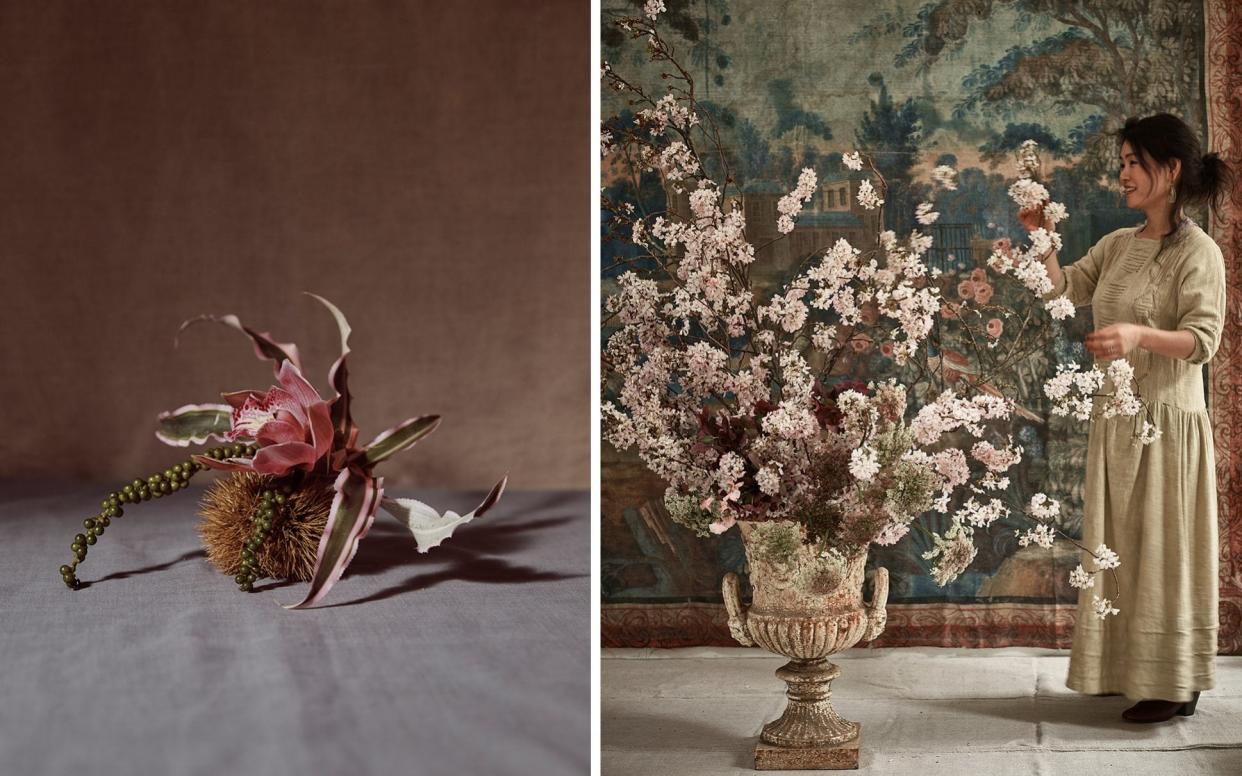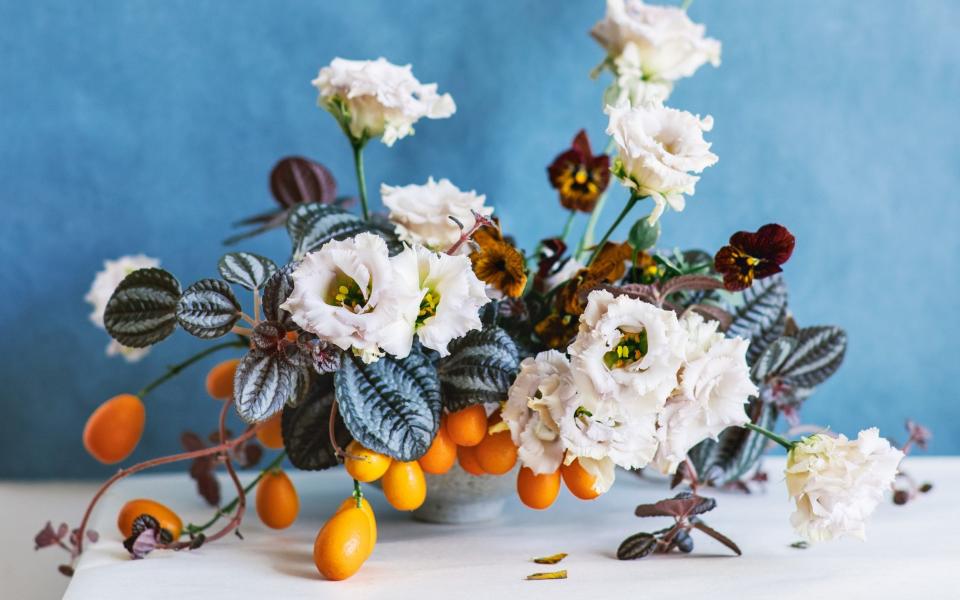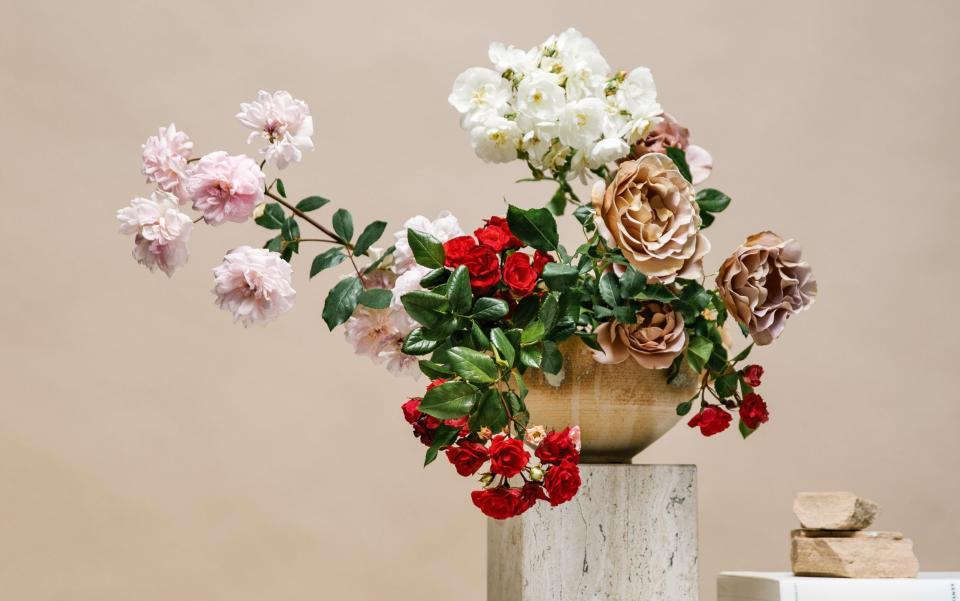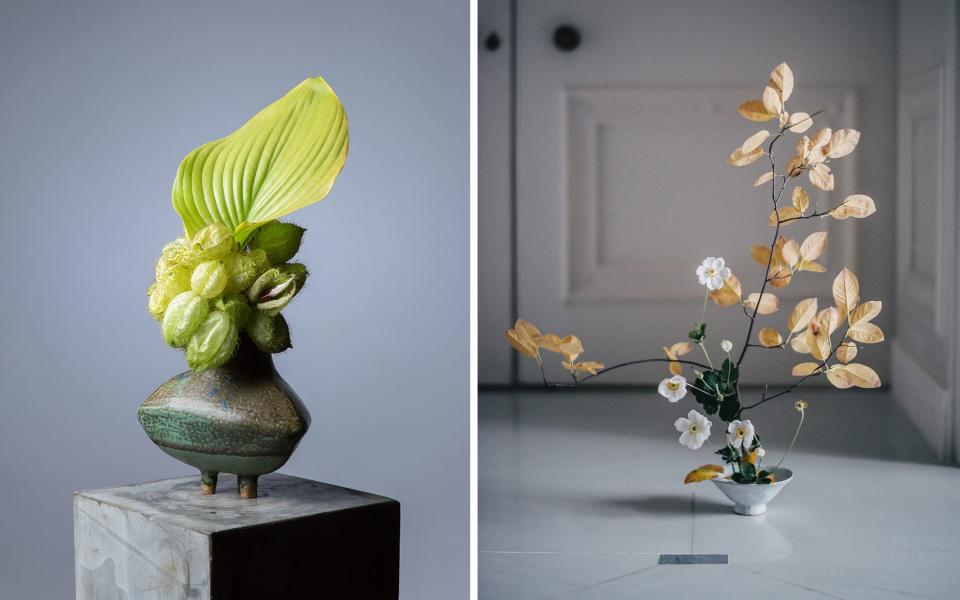Art meets horticulture with ikebana, the soothing art of Japanese flower arrangement

Back in February, Frida Kim, one of London’s most sought-after floral designers, was already fully booked until October with commissions for dinners, parties and private events across the city and beyond. By late March all of those jobs, like those of almost all of the country’s event florists, were cancelled.
Luckily, she also has several private clients, and was able to work alone, beautifying houses with her soulful displays that seem to sit somewhere between floristry and decorative art. “I am always checking for harmony and elegance,” says Kim, who often uses just one branch or stem rising up from an elegant bowl.
“Sometimes when I see one really beautiful single stem it can speak about our current situation – you can’t show off, you can’t go anywhere, there is all this worry about the whole world.”
It’s a metaphor that over the summer months seemed to come to life when she began sharing mesmerising films on Instagram of floating stems of old man’s beard, dried ferns or billowing grasses that would move gently on the breeze of a nearby window or person passing by.
Kim grew up in South Korea and worked as a jewellery designer before moving to the UK in 2012 and becoming seduced by flowers. Her light-bulb moment happened during a winter visit to the Chelsea Physic Garden.
“I fell in love with the English winter garden that day – because we don’t have that in Korea,” she says. “Back home winter is all white. I got a real shock with these beautiful naked trees, all the fronds of plants and the hydrangeas – especially the hydrangeas.”
She retrained as a florist and is now part of a growing cohort of florists who draw on ikebana, the Japanese art of flower arranging, creating sculptural displays that are a world apart from the more-is-more Western floral arrangements that have, in various styles, dominated the past few decades.
Even if you’re not familiar with ikebana, it’s very likely that you’ve felt its influence in the precise arrangements of artfully placed branches, in the ethereal installations of cloudlike blooms and the minimalistic displays that have been scattered through social media, shop windows and the pages of interiors magazines over the past couple of years.
Although it’s a diverse school, without one definitive style or one set of rules, its guiding principles have chimed with a new generation of florists who share ikebana’s deeply considered and highly stylised approach, its sense of harmony, its boundary-pushing embrace of different mediums but, perhaps most of all, its reverence for the natural world.

It’s thought that ikebana has its roots in the sixth century, when Chinese Buddhists, who travelled to Japan as missionaries, created floral offerings as part of their religious practice, although a deep appreciation of flowers and plants was already entrenched in Japanese culture and the Shinto faith, in which God resides in everything.
The Ikenobo school was founded in Rokkaku-do (which would become Kyoto) in the Asuka period in the early seventh century by Ono no Imoko, who began to develop rules that would eventually form the basis for the rikka style of tall and quite formal arrangements – from this other styles evolved such as shoka, which reduces the arrangement to three key components representing heaven (shin), man (soe) and earth (tai) – creating an asymmetric triangular shape that is still associated strongly with ikebana.
Now the discipline is being brought into focus by two new books. Earlier this month San Francisco florists Amanda Luu and Ivanka Matsuba of Studio Mondine published Ikebana Unbound: A Modern Approach to the Ancient Japanese Art of Flower Arranging, which takes readers step by step through exquisite and sculptural arrangements through a series of beautiful how tos, often using the most accessible of foliage and flowers plucked straight from the garden – blossom branches and ornamental grasses, trailing vines and climbers, shrubs and wild flowers – or sometimes even snipped from house plants.
And last week Victoria Gaiger and Tom Loxley, the duo behind Rakes Progress magazine, released Modern Ikebana: A New Wave in Floral Design, which is a global survey of contemporary floral designers who are divided into four categories: Modern Masters, Floral Contemporary, Punkebana and Floral Sculptors.
London-based Kasia Borowiecka, one of the Punkebana florists profiled in the book, grew up in Poland with a fascination for Japanese culture and ikebana after stumbling across a book on the subject. “It was such a minimal aesthetic and it appealed to me because it was so different to anything I knew from home,” she says.
She didn’t think about working with flowers until 2018, by which time she was living and working in London and came across an article in The Plant magazine about the Sogetsu school and started studying with one of its tutors, Shoko Koizumi- Hanson.

“You look at each flower or foliage and you analyse every angle of it and try to find the best material for your work,” she explains. “You have to think about the viewer and how the eye is going to lead through an arrangement.” Like all schools of ikebana, there are countless rules to observe as a Sogetsu student from the myriad angles and their relationship to each other to the exact placement of the kenzan (a dome of pins that holds stems in place) in the vase or vessel.
“It’s so complicated, especially at the beginning and it’s really difficult to remember them all and get your head around it,” she says. And yet, she adds, these are universal principles of a sense of harmony and balance that is intrinsic in all good design. “Even if you don’t study ikebana you probably still think about it,” she points out.
Central to ikebana’s philosophy is the idea of wabi sabi – a concept that has infused not just flowers but contemporary art, craft, design and the influential minimalistic interiors of designers such as the Belgian Axel Vervoordt – in which there is also an acceptance and celebration of imperfection and impermanence; it’s the Buddhist idea that nothing lasts and nothing is perfect – a Zen approach that feels particularly potent for our current times.
It’s why a gnarly garden-grown stem, placed artfully in a beautiful bowl, has usurped a pristine dome of perfect roses in full flower, for example. But it’s also about giving those imperfect specimens the space to be enjoyed in their own right.
For Kim, who is also profiled in Modern Ikebana, this is the critical difference between ikebana and the western approach to flowers. “In the west, whether it’s interiors or flowers there is the idea we have to fill it. In Asia, we make spaces empty,” says Kim, who admits then when she is working for clients she often feels she needs to add more because of our perceived value that more equals better.
“We have this association but when I add more it’s not right,” she explains. “But when you leave off, when you remove more flowers or stems you are going to get more.”

But perhaps ikebana’s ability to become a meditation of sorts is also fuelling its popularity. “When I am in a class I find it therapeutic – it’s just me and my teacher, we look at plants and showcase them in a more beautiful way than they already are,” adds Borowiecka. “You slow down and you are in that moment. But I also notice that I am really paying attention to everything around me in nature, too.”
Before retraining she was burnt out in her job as a data analyst in the charity sector. “I was one of those people, working like crazy for so many days without a break and you’re so tired you don’t have time to even look around you,” she says. “I just couldn’t do it any more – I found that flowers healed me and allowed me to come back to my old self.”
For Borowiecka, ikebana flowers provide the perfect distraction from anxious times. “You don’t have to spend a lot of money on flowers, you can buy something quite simple from the supermarket but that moment where you are creating gives you distraction from everything else that is happening around us at the moment,” she says, citing the lockdown as a potent reset on our attitudes towards nature and the realisation of how important it is in our lives.
“Creating flowers and maybe learning about how to put them together is so helpful for anxiety and mental health. You are doing something for yourself but also for others – it’s so nice when you can gift what you’ve made for something else.”


